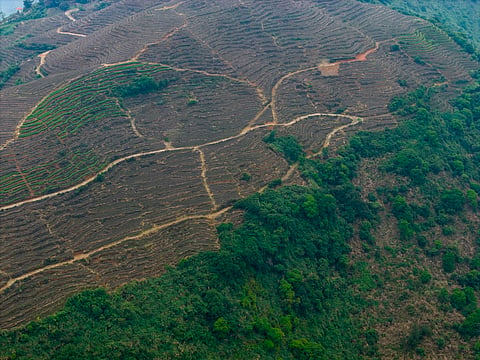

New study links tropical deforestation to nearly 28,000 excess deaths annually between 2001 and 2020
Loss of forest cover has driven local warming of up to 0.7 degrees Celsius in some areas
More than 345 million people exposed to deforestation-induced heat, with the highest mortality in south-east Asia
Researchers warn estimates are conservative as wider global impacts of deforestation not included
Deforestation in tropical forests has driven up local temperatures, causing nearly 28,000 excess deaths every year between 2001 and 2020, according to a new study.
The research, published in the journal Nature Climate Change, found that around 345 million people were exposed to local warming linked to deforestation. Daytime land surface temperatures rose by an average of 0.27 degrees Celsius (°C), which contributed to higher mortality rates — with the toll highest in south-east Asia, followed by tropical Africa and the Americas.
The authors noted that in recent decades tropical forests have suffered extensive deforestation and degradation, largely due to logging and agricultural expansion. These practices have not only stripped away vast forest areas, but also damaged biodiversity, altered the global climate and hydrological cycles and affected human communities.
The study added that heat exposure reduces cognitive performance and labour productivity. Between 2003 and 2018, an estimated 2.8 million outdoor workers lost safe thermal working conditions. Yet until now, there has been less research on how deforestation-driven warming contributes to mortality in the tropics.
Surface temperatures in these forests generally rose due to deforestation, compounded by climate change. Annual mean warming was observed at +0.34°C in tropical Central and South America, +0.10°C in tropical Africa and the highest in South Asia at +0.72°C.
The regions that recorded higher temperatures were spread across the tropical belt worldwide.
Scientists measured “pixels” of one square kilometre that experienced at least a 2 per cent loss of forest cover between 2001 and 2020. They found that 60 per cent of pixels with warming greater than four standard deviations from the mean (4.4°C) overlapped with deforested areas. On average, annual mean warming in deforested locations exceeded +0.70°C, compared with +0.20°C in regions that maintained forest cover.
The greatest warming corresponded with the greatest forest loss, notably in the Arc of Deforestation in the southern Amazon and in Sumatra and Kalimantan in Indonesia. The Arc of Deforestation is the region where the agricultural border advances towards the forest and also where the highest rates of deforestation of the Amazon are found, corresponding to about 500 thousand km² of land.
Other hotspots included Central America (Guatemala and Nicaragua), southern West Africa (Ivory Coast, Ghana and Nigeria), Central and Eastern Africa (the Democratic Republic of the Congo, Uganda and Tanzania) and mainland south-east Asia (Cambodia and Vietnam).
These areas are home to more than 3.5 billion people, with about 452 million (or 13 per cent) living in zones where deforestation occurred during the two decades studied. Around 345 million people were exposed to deforestation-induced warming, including 33 million who experienced more than +1°C, eight million above +2°C and 2.6 million exposed to increases exceeding +3°C compared with the annual mean.
“Across the tropics, 76 per cent of people living in regions of tropical forest loss were exposed to deforestation-induced warming, with a similar proportion in the different tropical regions (74-80 per cent). In tropical Africa, 148 million people were exposed to warming from deforestation, compared with 122 million people in Southeast Asia and 67 million people in tropical Central and South America,” the study noted.
The heat exposure translated into an estimated 28,330 non-accidental deaths every year. The mortality burden was highest in south-east Asia, with 15,680 excess annual deaths, largely due to the region’s high population density and vulnerability, particularly in Indonesia. In tropical Africa, deforestation was linked to around 9,890 excess deaths each year.
The researchers cautioned that these mortality figures do not account for health effects linked to wider regional warming or populations outside deforested areas. For instance, tropical deforestation also releases carbon dioxide, contributing to global warming. Between 2014 and 2023, deforestation released 1.7 gigatonnes of carbon annually, accounting for around 15 per cent of global anthropogenic carbon dioxide emissions.
“Global warming from the release of CO is not included in our study, meaning that our estimates of heat-related mortality associated with deforestation are likely to be conservative,” they said.